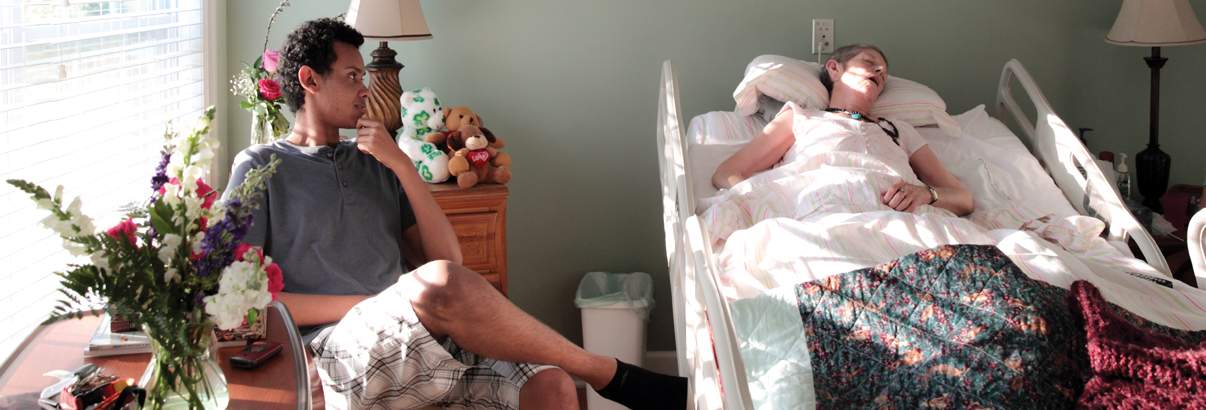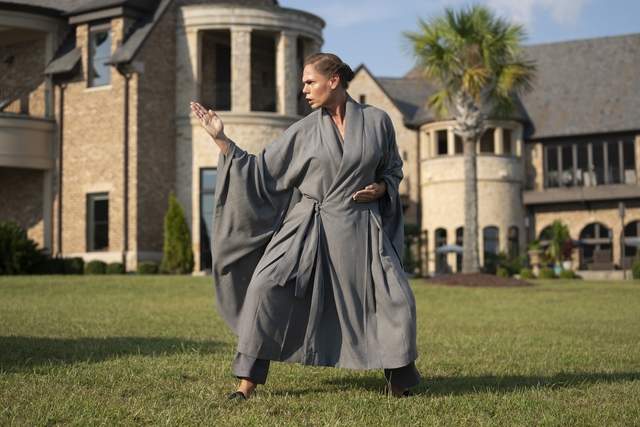At The Harley School in Rochester, New York, senior-year students who sign up for hospice class learn to care for people who are dying. These are lessons in compassion unlike any other.
“Have you done the Jumble yet today, Wendy?” Kayli O’Keefe has just bounced into Shepherd Home, a two-bed hospice-care home in Rochester, New York. The energy of the 18-year-old hoodie- clad teenager seems unexpected in a place where people go to die. She wants to know if someone has sat with Wendy yet so she could do her daily word puzzle.
Wendy, 52, is a former speech pathologist and college professor. But she can’t answer Kayli. She has frontal lobe syndrome, and it has rendered her almost nonverbal. She can utter the odd word or the odd letter from the puzzle, but mostly she hums repetitively, almost hypnotically, and communicates by holding her pink-polished thumbnail up or down. It’s the cruelest of ironies for someone in Wendy’s profession. She will also die from it, which is why she’s living at Shepherd Home receiving palliative care. Her disease has progressed so quickly that no one would recognize her from the photo of “healthy Wendy” on the whiteboard in her bedroom. It shows a vibrant woman whose smile dominates the frame.
Kayli moves closer to Wendy, who is doubled over by a bent neck, her eyes nearly closed, her face in an involuntary half-grimace. Kayli holds the newspaper and tells her what’s in the Jumble today. “The letters are R I N O Y. What do you think, Wendy?” Wendy is having a slow afternoon. Sometimes she can quickly blurt out the whole word, but this time she says only the first letter. No one else in the room can figure it out, but together Wendy and Kayli eventually do: IRONY.
• • •
Kayli is a volunteer at the hospice, but she didn’t come to this work in the usual way. She is here as part of a senior-year class offered at The Harley School, not far from the Shepherd Home. It’s a unique program Bob Kane started 10 years ago at the private school.
Kane is a beloved teacher whose graciousness and passion have attracted kids to the class, which is known in the syllabus simply as “hospice.” In the 2012-2013 school year, 36 of the school’s 44 seniors took it, up from nine when the course began in 2002. It’s popular. And at this critical time in their lives, when they’re about to go out into the wider world, it can alter their perspective about what’s important in life.
On the first day of class in September, the students are timid and curious, unsure about what to expect. Jocks, preps, nerds—the usual high school labels fail to stick in the face of the experience of death.
“They all come in afraid,” Kane says. “They come in wondering about everyone around the table. But the course calls to them because it’s real and it’s authentic. It’s extreme caregiving.
“We sit around the table the first day and I ask them some questions,” he says. “Why are you here? What drew you in? And then the big one: What is your experience with death—any kind of death, pet, loved one, family member, friend?
“That’s when the breakdowns start to happen,” says Kane. “It just takes one trigger—one person who begins to talk and their voice breaks. Once one person starts to go, they all step up and comfort each other. And it progresses from there.”
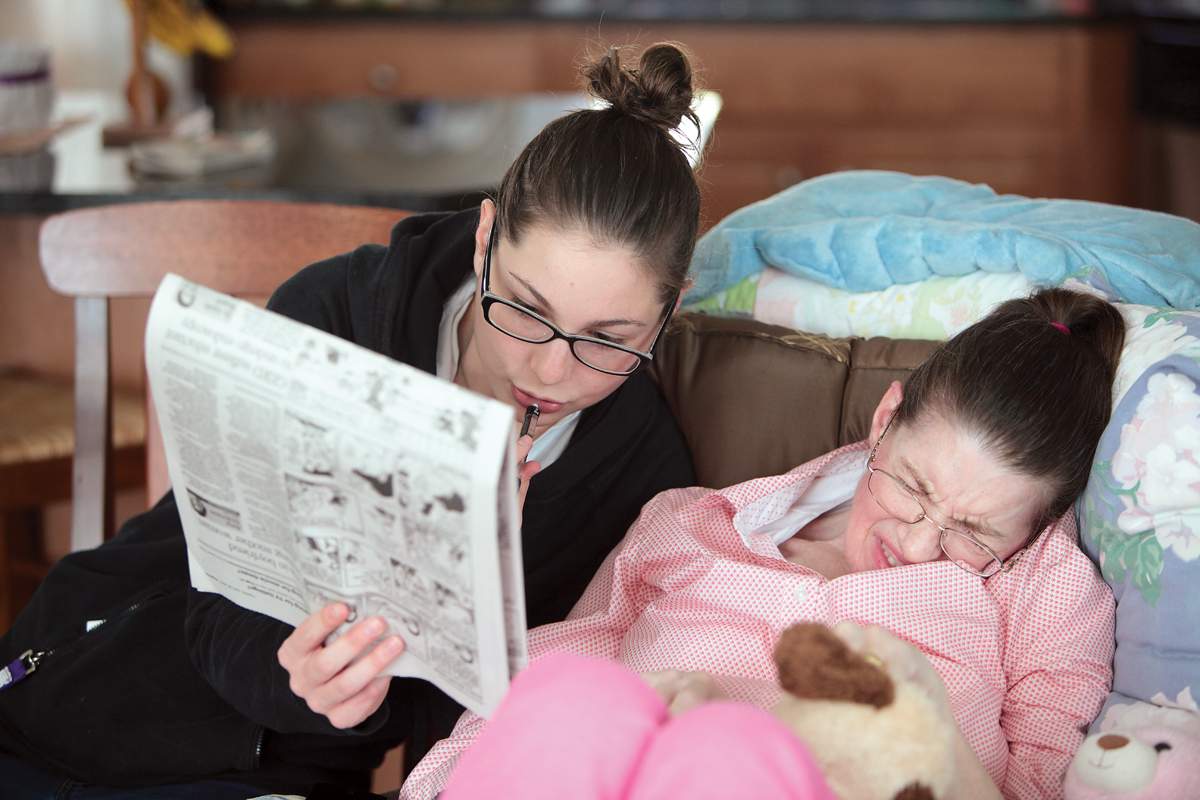
Alejandra Biaggi, 18, recalls the first day: “Some of us were tearing up,” she says. “My grandfather died last summer, and talking about it was such a release. Nowadays death is so taboo.” But for students who take Kane’s class, it’s a subject they’re all able to talk about now. “Death is just a part of life,” she says.
After the experience of opening up and coming together, Kane begins the hands-on training needed for hospice care: positioning residents in bed to make them comfortable (as part of the hospice philosophy, they don’t call them patients); changing the bed while the resident is in it; sponge-bathing, showering, feeding, hydrating, and applying lotion to delicate skin.
At that point, the students begin to visit one of four hospice houses that have signed up for the program. Rochester has more two-bed hospice homes than any other city in the U.S. Under state law, hospice homes with only two beds are allowed to operate as homes, not hospitals. Add another bed and it becomes a legislated health-care facility, and the cost per bed jumps from $100,000 a year to $175,000 a year because of the need for full-time nursing staff. Two-bed hospice houses can run with one director, volunteers who come on two-person shifts from morning to night, a paid nursing assistant who stays overnight, and an on-call nurse who comes when needed, such as to confirm a death.
The students sign up for shifts—there’s no set number they need to fulfill, but some become so dedicated, they elect to put in hundreds of hours. At that point, the classes at school become a forum where the students can share and process their experiences.
As she prepares to graduate, Carolyn Rumrill, 18, says she has learned to see the big picture: “At this stage, we’re expected to figure out our lives— where we’ll go to school next year. You need to do well in extracurricular and academics, so it’s really self-centered right now. This course moves you away from that. It’s not all about you. There are many aspects to life, so don’t freak out about every little thing. I also feel like I’ve become more attuned to listening instead of speaking.”
• • •
Kane asks his students who wants to do the honors. “I’ll light it,” says Carolyn as she reaches for the candle sitting on the table in front of them. The candle is lit before every class. It reminds them that life is as fragile as the flickering light.
It reminds them that in reality we’re nothing but a breath away from death. Once it’s lit, the students start sharing their experiences. Kane asks who’s had a shift recently and what happened.
“We have a new resident named Chet,” says Emily Hanss, 18, who volunteers at a hospice-care home called Advent House. “He has four children. They were all there on my shift and his wife was there. He had written a book about his life. I started reading it and it’s so cool to hear all these memories. I think that’s so nice for his family to have.”
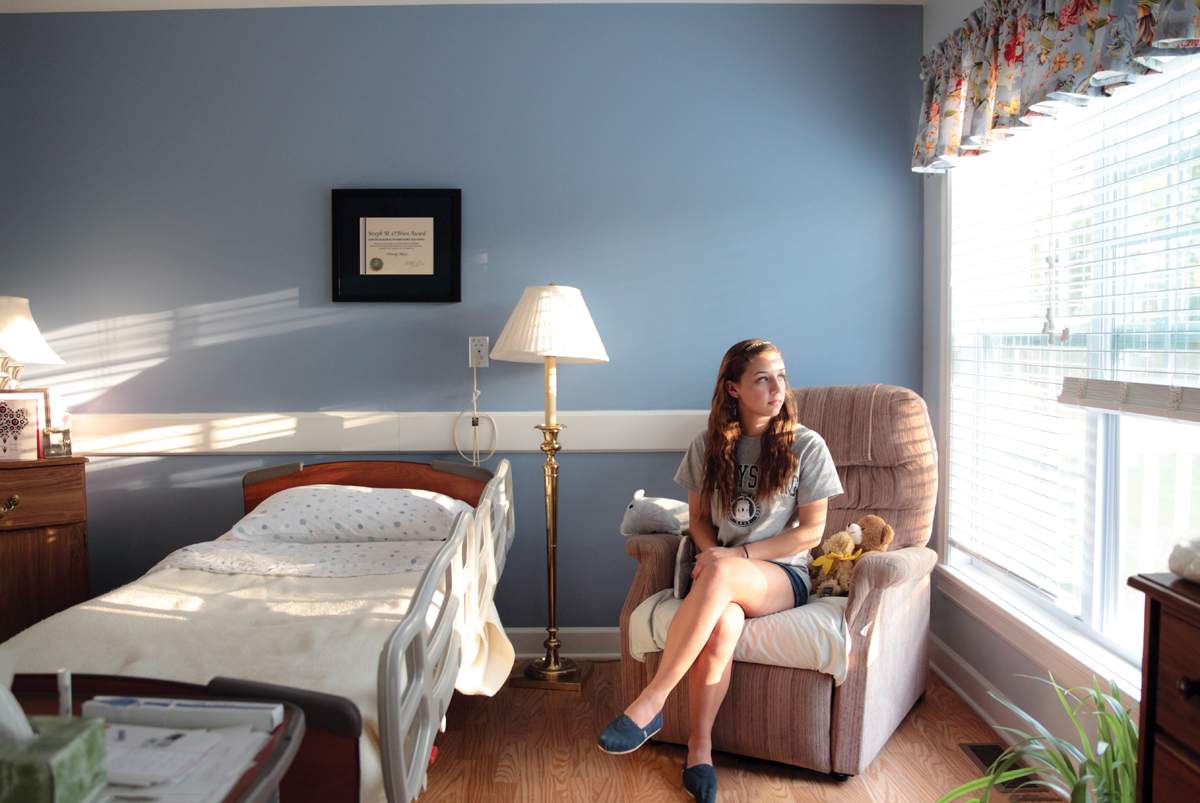
Alejandra Biaggi chimes in: “His entire family was there on my shift, too, and they are such a joy. The atmosphere was so hopeful.
“I had some time to read the book,” Alejandra adds, and then moves on to the nitty-gritty of his health. “He’s a little uncomfortable. He was dry and flaky, so we repositioned him. We lotioned his feet and talked to his family. He was very polite, in high spirits and clear mentally.”
“So, you’ve got relationships started,” says Kane. “This is lovely.”
That night, Madeline McGrain Githler is on shift at Advent House. She talks to Chet’s wife and son and does what she can to make him comfortable. The next day, the students find out that Chet died overnight. Madeline was on shift when it happened. After his morning class, Kane seeks her out.
“Are you okay?” he asks. “Do you want to share or talk about it?”
“It was really fast,” Madeline says. “He was really badly mottled on his arms. He was really sweaty, too, and he had the rattle. But some people have that rattle for, like, a week.”
Madeline tells him he seemed comfortable but that his wife was understandably upset. “I asked her if she wanted a hug and she said okay,” she says. She mentions that she was the one who had to inform the on-call nurse. “Then I had to call the volunteers who were coming after me. They were all pretty sad. It was strange because he looked the same.”
Kane tells her they’ll share in her afternoon class. With a hug, he adds, “You’re a great person and you did great work.”
• • •
Delaney Glaze is working on the class’s yearend project, a quilt made of squares dedicated to the memory of hospice residents they met during the year.
Delaney began hospice the same way her classmates did, but then it got personal. Her grandmother was diagnosed with brain cancer and had less than two months to live. Delaney approached the director of Shepherd Home where she volunteers, to see if she could get a bed for her grandmother. She arrived at the home in November and died in early December.
“The only way empathy is stimulated and nurtured is through touch and contact—when you’re in a vulnerable position but you’re willing to open up.”
Hospice teacher Bob Kane
For Delaney, it was an eye-opening experience to be on the other side of the bed. “At first, I was afraid to go into the rooms at hospice because I didn’t want to bother anyone. But I realized how much the families appreciate it. Now I feel much more comfortable with everything.”
The quilt piece Delaney is making is dedicated to her grandma. She has a photo of herself with her two sisters and her grandmother, which she’ll stitch on to the fabric from one of her grandmother’s favorite bead-covered shirts.
“She wore it on her 80th birthday,” she says of her card-playing grandma, who was lovingly referred to as Little Momma. “I asked her if I could use it for the quilt.”
Delaney was at the hospice the day her grandmother died but had left about five minutes before it happened. Her sister Tessa, her dad, and her uncle were there. “I knew what to expect. We had made a huge list of all the signs to watch for in the death process. It was helpful—I knew what it was going to look like.”
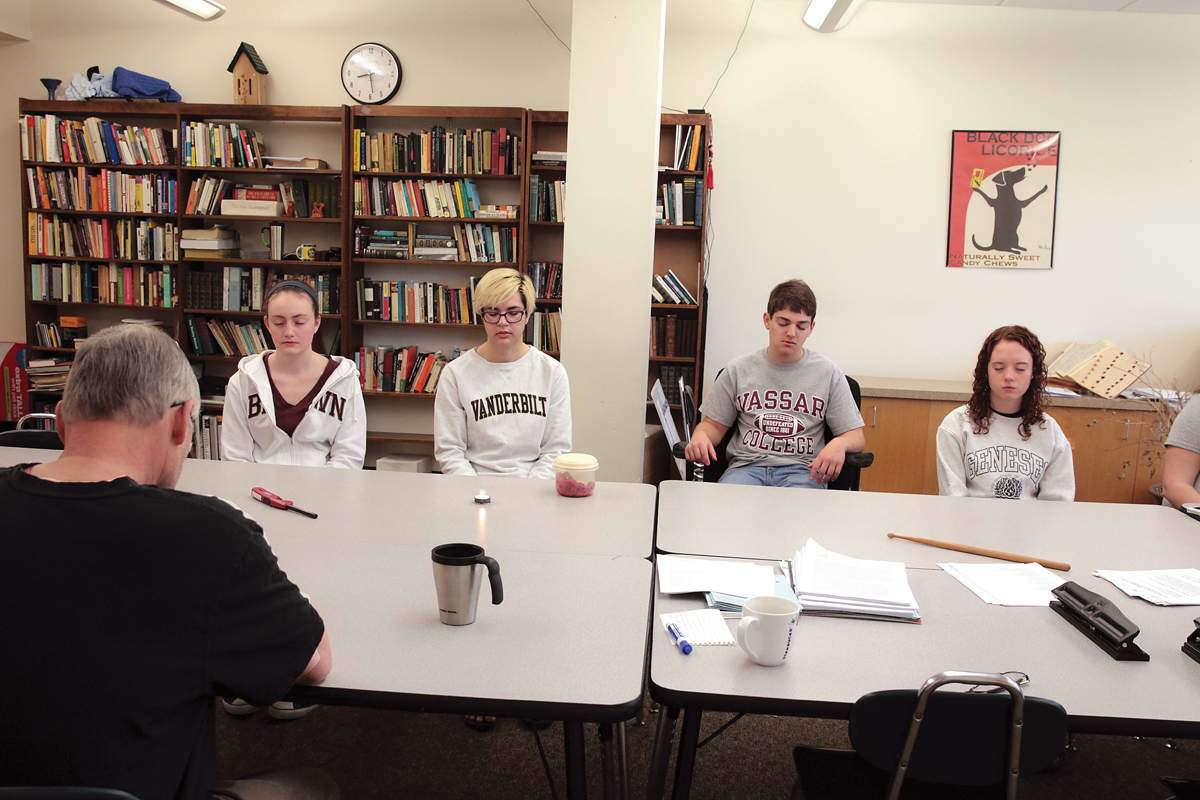
Beside her, Kayli O’Keefe is making two quilt squares. One is for Wendy, the former speech pathologist, and one is for her other favorite resident, a Dallas Cowboys fan named John. John’s square is a Cowboys shirt. Kayli now knows that a field goal is worth three points, but he taught her about more than football.
“John was 52,” says Kayli. “It was definitely weird for me, thinking ‘Wow, that could be my parents right now.’
“He was a huge a football fan,” she says. “Everyone would come over on Sunday—family and friends, all wearing their jerseys, and they’d watch football with him all day.
John had a wife and three children, ages 12, 14, and 23, and they were often at the hospice. But some days, it was just him and Kayli. “I feel like I got the whole experience with him,” she says. “I met the whole family, but I would also get his dinner together, help him eat, put him to bed.”
What did Kayli learn through John? “That everyone is going to go. My parents aren’t going to live forever, and I can only hope they are in such a good environment when they are dying.”
Other lessons emerge in the students’ sharing class. Andrew Regelski, 18, notes the contrast between hospice and other classes, most of which have a competitive aspect. “In this class, all of those barriers are eliminated. We’re all just people and we’re working together to help other people. It’s ironic how many life lessons you learn in a class about death and dying.”
Sofoniyas Worku, 18, a native of Ethiopia, lost his aunt and a friend to malaria. “I used to think it was terrible when someone died. But now I know they’re usually in pain and then they’re not in pain anymore. They’re resting; they’re in a better place; they’re not taking horrible medications.”
• • •
David Marshall is an Emmy Award-winning documentary filmmaker who followed Bob Kane’s classes at Harley for two years. His not-for-profit organization, Blue Sky Project, creates and distributes documentary films focused on underreported social issues. In his film Beginning with the End (which is complete but has not yet hit the film-festival circuit), the question Marshall seeks to answer is: Can empathy be taught?
“At hospice, you never hear students talk about money, position, power, the clothes they wear, or the house they have. It’s all about who they loved and what they did that mattered, in terms of interpersonal connections,” he says. “These guys are getting watered with empathy in a very fertile way. They’re hearing it and seeing it over and over again. For many of them, they realize they may be the last person this resident talks to.”
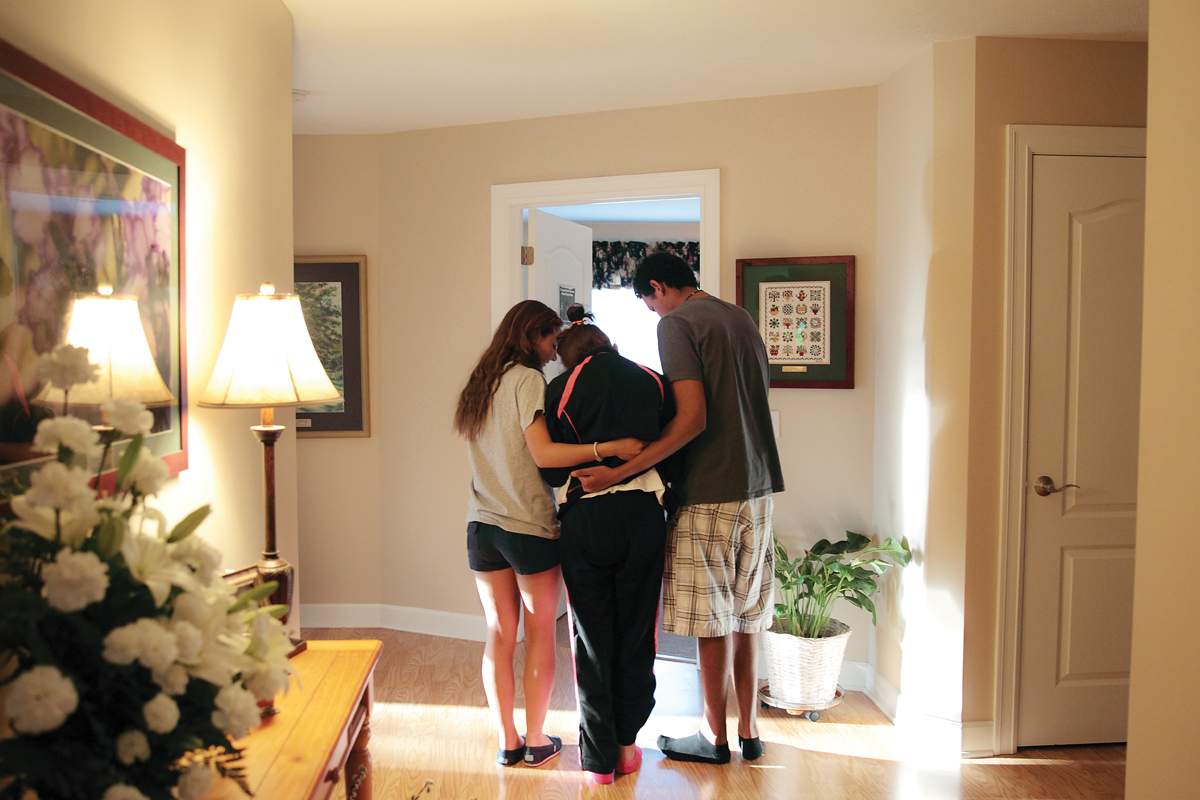
Marshall stresses that the students are just regular kids, something he managed to capture by giving them all video cameras and asking them to document what they do for fun outside of school.
“It would be easy to see these kids as a special group of kids—kids who are somehow better than other kids,” he says.
“They’re just regular run-of-the-mill students,” Kane says in a clip from Marshall’s film. Case in point: After she talks about the profound experience of losing her grandmother, Delaney finds out her photo for this article won’t be taken until the next day. “Oh good,” she says with a little-girl grin. “I can do my hair!”
• • •
Is empathy something that can be taught? Bob Kane is circumspect.
“I guess it depends on what your model of teaching is,” says Kane, who finished teaching the course last spring and now has plans to move to Ireland with his wife, where he hopes to create a place of spiritual reconciliation in a lodge they have acquired. Another teacher continues his legacy at Harley. “If you are looking at teaching as a structured profession where people get a curriculum and all these standards, I don’t think so.
“It needs to be naturally woven in, and from what I see, the only way it’s stimulated and nurtured is through touch and contact—when you’re in a vulnerable position but you’re willing to open up. When you’re fearful, you step forward and hope the other person will reciprocate.”
Kane uses the word “stimulate” deliberately. Because he thinks empathy is in all of us, and it just needs to be prodded.
“When you start caring for people who are ill, you understand what empathy is. I think that death, the dying process, is something that is essential to teach and nurture empathy because we all have it in common.”
Memorable Moments at Hospice
Caitlin Richard, 17
“Midway through the year, a resident named Lucy was having trouble breathing. It was difficult and she was crying a lot of the time. It was hard to see that. But one shift, I came in and said, ‘Hi Lucy,’ and her whole face lit up. I didn’t even have to do anything. It was just being there. I don’t think I’ll ever forget that smile.”
Emily Hanss, 18
“I was with this one resident, Mary. She was agitated and nervous. I was sitting near her bed and I just held her hand. Eventually, she calmed down and fell asleep. It was such a beautiful moment. I’m not her family, but I could be there and comfort her.”
Meghan Sita Dewan, 17
“It’s the universality of the lives we lead. It doesn’t matter if we’re different in age or background. There’s always something we have in common, some way that our lives interact. I interact in my daily life with people who are a lot like me. They might not seem like they are, but they are.”
Sofoniyas Worku, 18
“Margay moved to a hospital because she got better at hospice and was too well to stay. I went and saw her there four times. The last time I visited her, her health had declined again. She recognized me but she couldn’t stay awake for long because she had taken really strong medicine. Later I was told that, 20 minutes after I left, she died.”
Carolyn Rumrill, 18
“Mary decided she needed a shower. I had never bathed someone before. I ended up doing her hair, massaging in the shampoo and conditioner. We all love it when we go to the hairdresser, and it was nice to be able to get her to relax. Her whole body just loosened. “There were moments when I’d be holding someone’s hand. They need that connection and are so grateful for you being there with them. A lot of times, it’s not the conversations—it’s being connected, so they’re not alone.”
Alejandra Biaggi, 18
“Mary and I were chatting away, and then I thought she was sleeping, so I stopped. She said, ‘I’m not sleeping yet, keep talking.’ I put lotion on her feet and her whole body relaxed. Then she said she liked my nails and wished her nails were done. So I did her feet and cut her nails. She sat there like a queen, and I loved it. She asked me to talk to her and tell her about my life. When my shift ended, I heard one of the other volunteers comment on her nails, and Mary said, ‘The beautiful girl who just left did them for me.’ That just made my day.”
Andrew Regelski, 18
“When we do our work with the attitude of ‘How I can bring their mood up, make them happy?’ we’re bound to have a good shift. That attitude extends into life after doing hospice for a while.”


